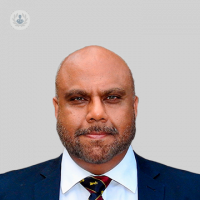An introduction to: flexible sigmoidoscopy
Written by:In his latest online article, Mr Parv Sains gives us his expert insight into flexible sigmoidoscopy. He explains what it is, how to investigate the bowel, the risks and the benefits of the procedure.

What is a flexible sigmoidoscopy?
A flexible sigmoidoscopy is a procedure that involves using a thin, flexible camera called a sigmoidoscope to examine the large bowel. The camera, which is approximately the thickness of a little finger, is inserted through the anus and guided along the left side of the colon. This examination focuses on the distal or end half of the bowel and typically lasts around 15 to 20 minutes. While it can be performed without sedation, some patients opt for gas sedation or intravenous sedation. However, the majority of cases are carried out using gas and air without the need for additional sedation.
The flexible sigmoidoscopy is an extremely valuable camera test employed to investigate the origins of rectal bleeding. When a patient presents with concerns about fresh red rectal bleeding, whether noticed on toilet paper or experiencing slight changes in bowel habits accompanied by such bleeding, we utilise the flexible sigmoidoscope to examine the left side of the bowel thoroughly.
There is another form of camera test called a colonoscopy, which is like a flexible sigmoidoscopy except we look all the way around the bowel. The flexible sigmoidoscope is a first line for things like fresh erectile bleeding and lower abdominal pain. This test is performed as a day case procedure, following a phosphate enema preparation to thoroughly clear the bowel. Its significance lies in the fact that approximately 75% of significant bowel conditions, such as bowel polyps or bowel cancers, tend to occur on the left side of the bowel.
This tool is immensely valuable for initial assessment to ensure there are no concerning issues in the bowels. Additionally, it offers an opportunity to thoroughly examine the lower end, allowing us to assess conditions like haemorrhoids, including their size, and subsequently develop an appropriate management or treatment plan for them.
How does it investigate one's bowel?
The flexible sigmoidoscope utilises optical fibre technology, incorporating a light source, lens, and camera at its tip, alongside various channels. By inserting the camera through the bottom end and channelling it up, we introduce carbon dioxide into the bowel to expand it. This allows us to directly observe the left side of the bowel up to about halfway around. Furthermore, the device permits the insertion of different instruments, enabling us to take biopsies when deemed necessary.
Using various instruments such as snares, we are able to remove polyps, while also capturing direct photographs of observed objects, making it an invaluable tool. Specifically, when examining the left side of the bowel, it is considered the gold standard. In cases where symptoms warrant it, a full colonoscopy may be necessary, but the flexible sigmoidoscopy is preferred for its efficiency, particularly when investigating fresher erectile bleeding and related symptoms.
What are the main risks?
The primary risks associated with flexible sigmoidoscopy are minimal. The likelihood of literal damage to the bowel wall or perforation is statistically very low when using this procedure. While there is a slight risk of bleeding, particularly when removing polyps, some patients may experience mild pain and discomfort during the process. Generally, though, people tolerate it well; discomfort may arise occasionally as we navigate the corners and bends of the bowel.
The most significant concern is perforation, but the chances of this occurring are also very low, especially if we administer sedation or intravenous sedation. While these sedation methods carry their own minor risks, they, too, are generally low. Overall, flexible sigmoidoscopy is considered a safe diagnostic procedure that provides valuable diagnostic information.
What are the main benefits?
The main benefits are a direct visualization or a direct look at the left side of the bowel fresh tread rectal bleeding is a worrying symptom for anyone but most of the cases are benign.
Upon patients' arrival, they understandably express concern about passing blood from the rectal area. Performing a flexible sigmoidoscopy allows us to thoroughly examine the bowel and provide reassurance that there are no worrisome issues present. If we do happen to detect anything more significant, such as a bowel polyp or tumour, the most effective way to diagnose it is through the collection of biopsies. In some cases, a full colonoscopy may be necessary.
However, for cases of bleeding from the lower end and other bowel symptoms, a flexible sigmoidoscopy serves as a highly accurate diagnostic tool and offers great reassurance to the patient if the results are normal. Subsequently, if we do identify benign problems like haemorrhoids, we can proceed with planning the appropriate management, whether it's conservative treatment, haemorrhoid banding, or surgery. Nonetheless, conducting the flexible sigmoidoscopy as the initial step is crucial to rule out any other potential causes of the bleeding higher up in the bowel.
Mr Parv Sains is a highly respected general surgeon with over 25 years of experience in his field. You can schedule an appointment with Mr Sains on his Top Doctor’s profile today.


